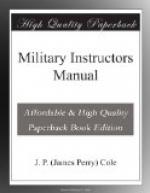E. Company commanders are responsible for the orders given to patrols, subject to any instructions which may be issued by higher authority. They are also responsible that all troops, whom it concerns, including companies on both flanks, are warned when and where patrols will be out, length of time they will be out, and of the points to which they will return.
F. Information gained by patrols is of little value unless transmitted quickly to those whom it concerns. Patrol reports will be made out by the commander of the patrol immediately upon his return and sent at once to the company commander unless orders to the contrary have been given.
4. Stand To.—A. “Stand to” will take place one-half hour after a relief has been posted and one-half hour before being relieved. At this parade every available man will be present. Rifles, equipment, clothing, etc., will be inspected. Firing steps will be tested as soon as practicable after reliefs have been posted to see that each man can fire on the foot of the nearest part of the wire entanglement which he is required to cover by his fire. The same procedure will be gone through at the “stand to” one-half hour before being relieved. Other “stand tos” may be ordered in the discretion of the company commander. These should be sufficiently often to insure that every man turns out promptly and knows his place in case of attack.
5. Machine Guns.—A. The concealment of machine gun emplacements is important. Consequently, it is only at night or in case of attack that machine gun crews will occupy their defense emplacements. At night guns should take up other position than their defense emplacements and fire a stated number of rounds in order to test out the guns and mislead the enemy as to their numbers and real emplacements, after which they will at once go back to their defense emplacements.
B. The guns and their crews will be tactically under the orders of the company commander in whose sector they are located, but no alteration will be made by him in their disposition or arcs of fire; he will, however, bring before the senior machine gun instructor any suggestions for improvements in machine gun dispositions for defense.
C. Two men per gun will always be on duty with the guns.
D. Range cards will be prepared and kept with each gun.
E. Officers and non-commissioned officers in charge of guns will remain in close proximity to the guns. They will frequently inspect their guns, emplacements, etc. They are responsible for cleanliness and maintenance of the emplacements.
F. Machine gun commanders are responsible for guns always being ready for action, and that emplacements are clear of all material except such as is required for the service of the guns; that embrasures or loopholes are kept clear of all obstructions which may interfere with fire or view.
6. Reliefs.—A. Reconnaisance. Prior to taking over the line of trenches the company commander, accompanied by his senior First Lieutenant and First Sergeant, will reconnoiter the trenches.




